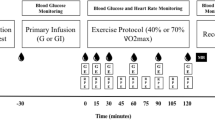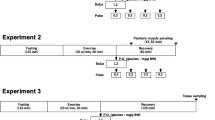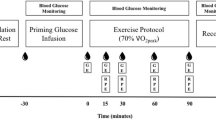Abstract
The utilization of 100 g glucose by 5 control and 5 glycogen depleted subjects was investigated during a prolonged exercise, using naturally labelled13C-glucose as a metabolic tracer in conjunction with continuous respiratory exchange measurements. 1 h after glucose ingestion, the subjects pedaled for 2 h at 40% of theirVO2 max.
In both groups, expired CO2 reached similar peaks of enrichment with13C after 75 min of exercise. At this time, control subjects used principally carbohydrate (65%), exogenous glucose representing 24% of the total energy expenditure. In contrast the glycogen depleted subjects used mainly lipid (70%), exogenous glucose representing 20% of the energy expenditure. In the latter subjects, FFA plasma levels remained 2 to 3 times higher than those of non-depleted subjects throughout the whole exercise period. Control subjects oxidized an average of 41±1 g and glycogen depleted subjects 38±2 g of exogenous glucose during the 2 h exercise period.
It is concluded that during an exercise which is preceded by the ingestion of glucose:
-
a)
The principal energetic substrate is carbohydrate for control and lipid for glycogen depleted subjects.
-
b)
Inspite of their glycogen depletion, these subjects do not utilize ingested glucose to a greater extent than the control subjects, which is probably due to their higher FFA plasma levels.
-
c)
The trend to store carbohydrate energy remains important during muscular exercise.
Similar content being viewed by others
References
Ahlborg, G., Feling, P.: Influence of glucose ingestion on fuelhormone response during prolonged exercise. J. Appl. Physiol.41, 683–688 (1976)
Ahlborg, G., Felig, P.: Substrate utilization during prolonged exercise preceded by ingestion of glucose. Am. J. Physiol.233, E188–E194 (1977)
Andres, R., Cader, G., Zierler, K. L.: The quantitatively minor role of carbohydrate in oxidative metabolism by skeletal muscle in intact man in the basal state. Measurements of oxygen and glucose uptake and carbon dioxide and lactate production in the forearm. J. Clin. Invest.35, 671–682 (1965)
Baker, N., Schreeve, W. W., Shipley, R. A., Incefy, G. E., Miller, M.:14C studies in carbohydrate metabolism. I. The oxidation of glucose in normal human subjects. J. Biol. Chem.211, 575 (1954)
Benade, A. J. S., Jansen, C. R., Rogers, G. G., Wyndham, C. H., Strydhom, N. B.: The significance of an increased RQ after sucrose ingestion during prolonged aerobic exercise. Pflügers Arch.342, 199–206 (1973)
Bergström, J., Hultman, E.: The effect of exercise on muscle glycogen and electrolyte in normals. Scand. J. Clin. Lab. Invest.18, 16–20 (1966)
Bergström, J., Hermansen, L., Hultman, E., Saltin, B.: Diet, muscle glycogen and physical performance. Acta Physiol. Scand.71, 140–150 (1967)
Bøje, O.: Arbeitshypoglykämie nach Glukoseeingabe. Skand. Arch. Physiol.83, 308–312 (1940)
Costill, D. L., Sparks, K., Gregor, R., Turner, G.: Muscle glycogen utilization during exhaustive running. J. Appl. Physiol.31, 353–356 (1971)
Costill, D. L., Bennett, A., Branam, G., Eddy, D.: Glucose ingestion at rest and during prolonged exercise. J. Appl. Physiol.34, 764–769 (1973)
Fitts, R. H., Holloszy, J. O., Rennie, M. J.: Effects of fatty acids and contraction on rat soleus muscle metabolites. J. Physiol. (Lond.)263, 160P (1976)
Goodman, M. N., Berger, M., Ruderman, N. B.: Glucose metabolism in rat skeletal muscle at rest. Effect of starvation, diabetes, ketone bodies and free fatty acids. Diabetes23, 881–888 (1974)
Hales, C. N., Randle, P. J.: Immunoassay of insulin with insulin-antibody precipitate. Biochem. J.88, 137–146 (1963)
Heindel, J. J., Cushman, S. W., Jeanrenaud, B.: Cell-associated fatty acid levels and energy-requiring processes in mouse adipocytes. Am. J. Physiol.226, 16–24 (1974)
Hermansen, L., Hultman, E., Saltin, B.: Muscle glycogen during prolonged severe exercise. Acta Physiol. Scand.71, 129–139 (1967)
Hickson, R. C., Rennie, M. J., Conlee, R. K., Winder, W. N., Holloszy, J. O.: Effects of increased plasma fatty acids on glycogen utilization and endurance. J. Appl. Physiol.43, 829–833 (1977)
Hultman, E.: Studies on muscle metabolism of glycogen and active phosphate in man with special reference on exercise and diet. Scand. J. Clin. Lab. Invest.19, Suppl. 94, 63 (1967)
Hultman, E.: Muscle glycogen stores and prolonged exercise. In: Frontiers of Fitness (R. J. Shephard, ed.), Springfield, Ill.: Ch. C. Thomas 1971
Hultman, E., Bergström, J.: Muscle glycogen synthesis in relation to diet studied in normal subjects. Acta Med. Scand.182, 109–117 (1967)
Jefferson, L. S., Koehler, J. O., Morgan, H. E.: Effect of insulin on protein synthesis in skeletal muscle of an isolated perfused preparation of rat hemicorpus. Proc. Natl. Acad. Sci. USA69, 816–820 (1972)
Jorfeldt, L., Wahren, J.: Human forearm muscle metabolism during exercise. V. Quantitative aspects of glucose uptake and lactate production during prolonged exercise. Scand. J. Clin. Lab. Invest.26, 73–81 (1970)
Lefebvre, P., Mosora, F., Lacroix, M., Luyckx, A., Pirnay, F., Duchesne, J.: Les sucres naturellement marqués au13C. Leur intérêt pour les études métaboliques chez l'homme. Journ. Diabétol., Hôtel Dieu 187–194 (1976)
Lusk, G.: Elements of the Science of Nutrition. 4th ed., p. 65. Philadelphia and London: W. B. Saunders 1928
Maehlum, S., Felig, P., Wahren, J.: Splanchnic glucose and muscle glycogen metabolism after glucose feeding during postexercise recovery. Am. J. Physiol.235, E255–E260 (1978)
Metropolitan Life Insurance Compagny, Statistical Bulletin40, tables 2 and 3 (November–December 1959)
Mirouze, J., Jaffiol, C., Sany, C.: L'enregistrement glycémique nycthéméral continu dans le diabète sucré. Pathol. Biol. (Paris)11, 553 (1963)
Neely, J. R., Morgan, H. E.: Relationship between carbohydrate and lipid metabolism and the energy balance of heart muscle. Ann. Rev. Physiol.36, 413–459 (1974)
Newsholme, E. A., Randle, P. J.: Regulation of glucose uptake by muscle. 7. Effects of fatty acids, ketone bodies and pyruvate, and of alloxan diabetes, hypophysectomy, and adrenolectomy, on the concentrations of hexose phosphates, nucleotides, and inorganic phosphate in the perfused rat heart. Biochem. J.93, 641–651 (1964)
Orava, S., Vapaatalo, H., Saarela, J., Reinilä, M.: Blood glucose, serum FFA and serum insulin levels after the intake of the carbohydrate rich solution before exercise in man. J. Sports Med. Phys. Fitness.14, 93–102 (1974)
Pirnay, F., Lacroix, M., Mosora, F., Luyckx, A., Lefebvre, P.: Glucose oxidation during prolonged exercise evaluated with naturally labeled13C-glucose. J. Appl. Physiol.43, 258–261 (1977)
Randle, P. J., Newsholme, E. A., Garland, P. B.: Regulation of glucose uptake by muscle. 8. Effects of fatty acids, ketone bodies and pyruvate, and of alloxan diabetes and starvation, on the uptake and metabolic fate of glucose in rat heart and diaphragm muscles. Biochem. J.93, 652–665 (1964)
Rennie, M. J., Winder, W. W., Holloszy, J. O.: A sparing effect of increased plasma fatty acids on muscle and liver glycogen content in the exercising rat. Biochem. J.156, 647–655 (1976)
Rennie, M. J., Holloszy, J. O.: Inhibition of glucose uptake and glycogenolysis by availability of oleate in well-oxygenated perfused skeletal muscle. Biochem. J.168, 161–170 (1977)
Smith, B. N., Epstein, S.: Two categories of13C/12C ratios for higher plants. Plant Physiol.47, 380–384 (1971)
Steele, R., Winkler, B., Rathgeb, I., Bjerknes, C., Altszuler, N.: Plasma glucose and free fatty acid metabolism in normal and long-fasted dogs. Am. J. Physiol.214, 313–319 (1968)
Wahren, J., Felig, P., Ahlborg, G., Jorfeldt, J.: Glucose metabolism during leg exercise in man. J. Clin. Invest.50, 2715–2725 (1971)
Author information
Authors and Affiliations
Rights and permissions
About this article
Cite this article
Ravussin, E., Pahud, P., Dörner, A. et al. Substrate utilization during prolonged exercise preceded by ingestion of13C-glucose in glycogen depleted and control subjects. Pflugers Arch. 382, 197–202 (1979). https://doi.org/10.1007/BF00583702
Received:
Accepted:
Issue Date:
DOI: https://doi.org/10.1007/BF00583702




